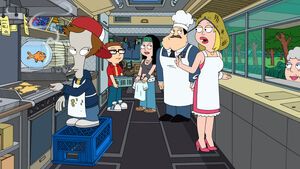Ambrose Bierce’s “An Incident at Owl Creek Bridge” is a harrowing exploration of perception, reality, and the fleeting nature of life in the face of death. The short story, renowned for its innovative narrative structure and poignant depiction of a man’s illusory escape from execution, has resonated with readers for over a century. A testament to its enduring power, the story has been adapted and referenced in various media, including a particularly memorable and uproarious parody within the animated sitcom, “American Dad.” This parody, found in the episode “An Incident at Owl Creek,” cleverly utilizes the framework of Bierce’s masterpiece to explore the comedic potential of the show’s characters, relationships, and absurd situations, offering a meta-commentary on storytelling itself. Let us delve into the nuances of this comedic reimagining and unpack its layered satirical intent.
I. The Foundation: Echoes of Bierce’s Narrative in Langley Falls
The “American Dad” episode takes a page directly from Bierce’s book, establishing a parallel narrative. Stan Smith, the ultra-conservative CIA agent, finds himself in a situation mirroring Peyton Farquhar’s predicament. Instead of a Confederate sympathizer facing hanging, Stan is threatened with execution during a training exercise gone awry. The initial set-up meticulously mirrors the opening scenes of the short story. The imagery and tone are carefully constructed to evoke a sense of impending doom and the fragility of life, setting the stage for the subsequent comedic subversion.
II. Divergence and Satire: Where the Parody Takes Flight
Here is where the deviation begins. While Bierce’s tale delves into the psychological depths of a man facing death, “American Dad” pivots towards outlandish humor. As Stan plummets to what he believes is his imminent demise, his mind conjures an elaborate and extended fantasy. This prolonged escapade, filled with implausible scenarios and characteristically absurd “American Dad” situations, stands in stark contrast to the relatively brief and focused dream sequence in Bierce’s original. The key difference lies in the purpose: Bierce sought to explore the human condition; “American Dad” seeks to elicit laughter through the subversion of expectations.
III. The Unraveling of Reality: Absurdity as a Comedic Tool
Stan’s imagined escape is a cascade of increasingly ridiculous events. He envisions a heroic return to his family, embarking on a bizarre quest involving talking animals, improbable disguises, and encounters with eccentric characters typical of the show’s repertoire. The show weaponizes the inherent absurdity of its premise. Each element serves to highlight the contrast between the grim reality of Stan’s simulated execution and the escapist fantasies that bubble to the surface of his subconscious. The result is a delightful juxtaposition of high-stakes drama and lowbrow humor, a signature element of “American Dad.”
IV. Character Dynamics Under Scrutiny: A Lens on the Smith Family
The parody does more than simply replicate Bierce’s narrative structure; it uses it as a vehicle to examine the interpersonal dynamics within the Smith family. Stan’s vision casts his wife, Francine, and children, Hayley and Steve, in exaggerated roles that reflect their established character traits. Francine is portrayed as both adoring and slightly oblivious, Hayley as idealistic and rebellious, and Steve as socially awkward and desperate for validation. These caricatures, while comedic, offer a perceptive commentary on the family’s inherent strengths and weaknesses, revealed under the heightened circumstances of Stan’s imagined plight. In fact, his relationship with Roger, the alien boarder, takes center stage as an unlikely duo navigate the treacherous landscape of Stan’s imagination. Roger’s outlandish personas and unpredictable behavior become integral to the comedic fabric of the episode, mirroring, in a warped way, the unpredictable nature of reality itself.
V. Meta-Commentary and Storytelling: A Wink to the Audience
Beyond the immediate humor, the “American Dad” parody offers a subtle meta-commentary on storytelling. The extended nature of Stan’s fantasy, its deviation from logical plausibility, and its embrace of the absurd serve as a nod to the conventions of animated sitcoms. It acknowledges the audience’s willingness to suspend disbelief and accept the show’s inherent unrealism. The very act of parodying “An Incident at Owl Creek Bridge,” a story renowned for its realism and psychological depth, is a self-aware acknowledgement of the show’s own identity as a purveyor of comedic escapism.
VI. The Ironic Resolution: A Return to the Mundane
The episode concludes with Stan’s return to reality, revealing that his entire adventure was a mere simulation. However, instead of a triumphant homecoming, he returns to the mundane reality of his everyday life, highlighting the contrast between his grand fantasy and the relatively uneventful nature of his actual existence. This abrupt return to normalcy underscores the episode’s comedic intent, emphasizing the absurdity of the entire scenario. The ironic resolution serves as the final punchline, leaving the audience to contemplate the juxtaposition of the extraordinary and the ordinary, a recurring theme in “American Dad.”
VII. A Lasting Impression: The Enduring Power of Parody
The “American Dad” parody of “An Incident at Owl Creek Bridge” is a testament to the enduring power of satire and the ability of comedic reinterpretations to breathe new life into classic works. By utilizing the framework of Bierce’s story, the episode provides a platform to explore the show’s unique brand of humor, its character dynamics, and its meta-commentary on storytelling. This episode, like the rest, is marked with subtle nods to the original work which invite a deeper appreciation for both the source material and the comedic artistry of “American Dad.” In conclusion, the parody offers a nuanced exploration of character, absurdity, and the very nature of storytelling, solidifying its place as a memorable and thought-provoking installment in the “American Dad” canon.
